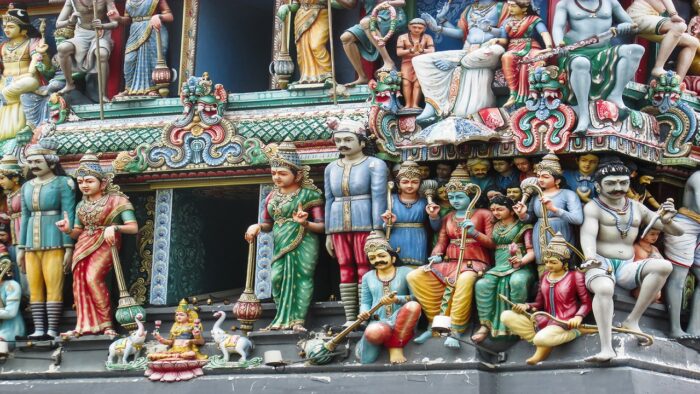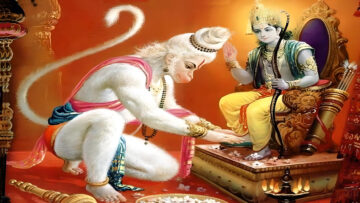About 14 billion years ago matter, energy, time and space came into being and it was called the Big Bang. In Indian tradition there was actually no trace of where or how the Universe came into existence but there was existence – also called as Brahman which only seers experienced. So experiences came into being called existence- satchitananda.
The meanings of the individual words of sat-chit-ananda are as follows:
- Sat: Truth, absolute being or existence– that which is enduring and unchanging.
- Chit: Consciousness, understanding and comprehension.
- Ananda: Bliss, a state of pure happiness, joy and sensual pleasure.
A common translation of sat-chit-ananda is “truth-consciousness-bliss.”
So Shiva and Shakti became the reflected consciousness of the absolute reality. Shakti borrows the reflected consciousness for creation.
Three important evolutions shaped the course of history: The cognitive revolution 70,000 years ago, the agricultural revolution 12,000 years ago when man became a settler and scientific revolution just 500 years ago.
Whether it was Charles Darwin’s theory of “The origin of species” in the West or the avataars in the Indian tradition both believed that we evolved from the animals, like in Charles Darwin’s theory from an amoeba to an amphibian to the flying birds to the four legged animals and to the apes – nature played a large part in the evolution of man.
In the oriental cultures we differed in theory about the fact of linear time. There was no beginning or end, only circular time. So in the avataars too it was the fish – Matsya, to turtle – Koorma, to Varaha – boar, to Narasimha – half man and half lion, to dwarf – Vamana and then the perfect being in Rama – Man and the brain that grew strategically like Krishna.
In the food chain, for millions of years humans hunted smaller creatures while being hunted by the larger predators. But only in the past 1,00,000 years that man jumped onto the top of the food chain.
The key element from nature that he found was fire. There is a tribal story from Karnataka’s Nagarhole forests by the Jenukuruba tribe (bee gatherers) about how they discovered fire.
The Stories
What man feared initially – like thunder, lightning, water and fire he worshipped and made them Gods. In the early civilizations like the Egyptian, Indus, Greeks we can find parallel Gods like Ra – the Sun God, Surya in Hinduism, Helios or Apollo etc.
When did stories actually evolve? From the time perhaps that man invented the fire about 70,000 years ago and cooked his food was perhaps the first time he shared, communicated and spoke about his experiences with others around the fire.
So when man wondered, he created tales and myths about the unknown. Myths came into being and the Greek myths or the Egyptian myths created stories to help folks understand, fear, learn and wonder.
The story of Bellerophon, the winged horse similar to Airavat in our Indian traditions or Sphinx in Egypt had similar references.
The fire played a significant role in the evolution of storytelling as almost around the world at the same time when man settled he created the fire and told tales around them.
These came to be the earliest form of storytelling called folk tales.
Definition of folk tales – Passed down from one generation to another by word of mouth and mostly involved the immediate environment or rather the local motifs- For instance in India you would find the banyan tree , an elephant, a monkey or a peacock as the main characters of folk tale rather than a kangaroo or a coyote.
The basic definition of a folk –meaning people sitting around the fire and talking and sharing tales – this happened almost in all the ancient civilizations of the world. The key element was fire, once the early man discovered fire and it helped him to settle.
In the Panchatantra, Hitopadesha, Jataka tales there are traits given to the animals and birds which were taught through five books to the children of the King by Vishnusharma.
How Did We Learn To Communicate?
Every animal knows how to communicate. Even insects, like bees and ants know how to inform the other about the whereabouts of food. Many animals including apes use vocal signs. A parrot can even imitate human sounds. So what made it special about our language?
Our language is amazingly supple. We can connect with a limited number of sounds and signs to produce an infinite number of sentences, each with a distinct meaning.
In the Indian tradition we also gave importance to thought waves and knew that the eagle could sense the wind or that a snake could sense very clearly any movement miles away from where it was.
Our saints and seers gave importance to intuition to figure our chants and in the forests could receive and perceive sounds to convert them into chants like the sound of Om.
When the sages of the Upanishads are speaking of nature and speaking of the sacred they were drawing deep connections between nature, human beings, and life. These insights reveal to us a renewed understanding of the way we should relate to nature that not only realigns us to the natural world but also deepens our relationship with ourselves and transforms us. Drawing from my own experiences of living amidst nature, I sincerely believe that these texts hold the key to a renewed understanding of nature that is relevant even today.
In the native American myths too when Chief Seattle addresses George Washington he tells him that he could sense the horses galloping as he lies down on the ground and sense the water go up the plants and feel the bud blooming and that he could sip the river waters so pure and crystal clear and the wind approaching him on all sides, and then later in the speech he mentions he is afraid that the horses will be tames and the buffaloes all slaughtered etc.
Our Creation: Myths and Transformations
Mythology more pertinent to early civilizations but also Celtic myths bring in nature – for instance the tale of how the seal maiden is transformed into a maid and in our own stories by A. K. Ramanujam of the flowering tree where the maid becomes a tree by night. Transformation of animals into humans like the werewolves, the story of Arunagirinathar of flying like a parrot in the sky, the Ramayana where Ahalya becomes the maiden from a stone, the grandfather rock which tells Native American stories, or the crow that brought fire to Ireland, are all examples of how the stories evolve.
Again crow as a symbol in ancestral worship in India and how the grandfather rock was offered food every day and symbols of offerings to tree spirits.
Anansi folk tale combined with creation myths.
In ‘Women Who Run With The Wolves’, the author describes women actually evolved from wolves and so are called wolf women.
Significance of Trees
Like the Christmas tree in the west we have serpent stones that are put up where two banyan trees meet and this stone is immersed in the pushkarni for days for the elements to get soaked in and then the same stone is kept at the meeting point of the roots. Snakes, especially the cobras mate here for many days and leave the sperm which is considered holy and the stone is now set up with two serpents mating as the symbol. When women desirous of having children circle around this stone they are supposed to beget children.
Some More Stories Woven:
Life after death is a concept believed by both Hindus and Egyptians. The soul after crossing the river is either sent to hell – like fires or finds liberation in afterlife.
The soul carriers are usually the crows or the clouds up to the moon.
Wrath of the Gods is depicted as thunder and lightning in many myths.
Rainbow saints in the Tibetan tradition – Rainbow colours after death and giving up the last breath on a full moon night.
Narada’s story of being a worm, then frog, cow and finally a human being.
In African myths too we have stories of how the fire or sun was brought to the earth through the crow and the grandmother spider who stole the sun.
The Upanishads are some of the oldest philosophical texts of Indian traditions. They are considered to be parts of the Vedas that focus on the reflected tradition of knowledge as opposed to the ritualistic traditions of the earlier parts. [i] MacCulloh suggests that even in the ritualistic parts of Vedas many verses eulogize parts of nature as deities. [ii] According to him, a sense of wonder about the natural elements made the Vedic people ascribe divinity and power to various elements of nature including the Earth, the Heavens, the Clouds, the Sun, and the Moon. These deities were energies or powers that controlled nature – such as the ruler of clouds and rain called ‘Indra’, the master of all waters called ‘Varuna’ and power of death called ‘Yama’.
Bushmen of Africa believed that at one time animals and people lived together in a land beneath the surface of the earth where happiness reigned. As they lived together The Great Master and Lord of All Life, Kaang (KŠng), planned a wondrous land above theirs. The first thing he created was a huge tree with branches stretching over the land. At the base of it, he dug a hole and brought the people and animals into another world through it. Some of the animals in their rush to reach the wonders of the world found a way to climb up and out of tree. A tree played a similar role in the Native American Hopi myth.
At the base of the Hopi culture was a myth recalling past worlds, beneath ours, where people used to live. When life in these worlds became unbearable the Native Americans discovered upper worlds and to get to them they climbed a pine tree. This pattern continued until they reached the present surface which may or may not be just another step on the ladder. Despite being separated by miles of water the tree leading to the new world appears in both myths.
In both the Japanese and Iroquois myths the creator’s home was in the land above the clouds. Two gods, Izanagi and Izanami, created the islands of Japan and the plants, rivers, brooks, animals and snow. Then they married and their descendants became the people of Japan. The Iroquois people believe that they and their surroundings were created by twin brothers, who were the children of a Sky Woman who fell from a hole in her home in the clouds.
Experiences with Divinity
Our Gods and Goddesses have vahanas and if you take, for example Brahma or Saraswati they have the swan as the vehicle – Brahma could not be attached to his creation, the mystical swan drinks only milk and leaves the water behind. Similarly, the experience of creation is to detach and not get attached to it. Following the age-old injunction “go to the forest and meditate,” I lived in the Himalayas on the banks of a river engaging in spiritual practices in an ashram. I realized that the exile from the settlement was not just an adventure but it was of a willing quest into spaces of exploration that led me to the same environment that produced these stories.
Whether it was the meadows of England, the moorlands in Scandinavia or the forests the tales where the reindeer or the horse or the tiger plays a significant part of the story use forests and lands as their natural background.
The stories were not only produced amidst nature but they were also as much about nature. This transformation of understanding of these texts is experiential and may perhaps be very contrary to what has been described in fairy tales or tales that are built up in a modern setting. But all I can claim is that personally, during this time I studied the myths and symbols of tales, I drew experiential insight from them that allowed me to deeply understand the relationship between nature, life, and human being.
It is assumed that one can make sense of them only through words and meanings that are interpreted through philosophical commentaries.
However, most of my interaction with the storytelling world gave me insights into the deeper processes and of a way of relating to nature that was sacred and uplifting. As one tries to reconcile with the normal spiritual teachings of these philosophies and the concept of nature as sacred, one is left with a deep sense of relationship with nature that seeks to reject landscapes, people, animals, birds and all the other entities of nature described in some of the modern tales as if they were unimportant and mundane, mere metaphors and examples that aided the loftier goal of discovering stories.
As one wakes up to a morning in nature the predawn silence seems to give into the sounds of the stirring forest, birds, insects, people, even the cracking fires all of which together create a symphony of sounds of life. Individually they are recognizable as individual sounds. But together they form inspiring evidence of the life of the vital force that moves them. These natural sounds are heard together like a hum.
Tales that are manifested as the beings and nature is the same life that reaches out to touch the phenomenal world through the senses from us. The presence of stories makes itself known to us through the sound. This life force is the essence of all beings. The life that reverberates in the outer world is the same life that courses through the heart of the human being. The presence of this life, this connection of the outer and inner, is a sacred nature of folk tales and stories. The possibility of a union of this inner and outer world is the ritual that makes nature sacred.
When in the city the weather was a mere inconvenience or convenience to the purpose of other activities. The clock time was calibrated and the days of the week were marked with appointments and life went on according to work, college, and movie show timings. In the forest, however one lived by nature’s timetable. Even the everyday broom was bound by annual time and season. The larger grass broom had to be gathered in the fall when it was just yellowing. The pine needles, however had to be gathered in summer when they were longest and strongest to make the finer brooms for the kitchen area. Life was annual, other dates and days made no sense. Cloud bursts, windy seasons, snowfall, flooding of the river, flowering apricot blooms, and the migration of monkeys marked the season for us. The rhythm of time was aligned to nature, the days in winter were shorter and often we spent only about seven to eight hours awake.
We rearrange the earth to make it a city.
This is where going to the forest becomes a symbol of accepting nature within us and outside of us. Such a nature was not separate from the human being.
No tree was alike, no path the same, not even the sky was the same every day. I lived amidst nature in the Himalayas, experiencing ‘dwelling’ in nature rather than visiting or seeing nature. Every tree, every rock and bamboo patch was familiar in the sense that it existed. Not that I had to know its scientific name, label the birds, or document the wildlife. It was enough that they were present.
To experience sacred in nature is to not measure, theorize, or mystify nature. This understanding of nature does not allow us to access the wisdom of stories. The human being was also nature and thereby formed an important part of the study to gain the wisdom of sacred nature.
We thus find every archetype hero of many Hindu stories repeats these journeys of moving out from the world of settlements, and then experiencing nature in the forest which transforms them. Rama (in the Ramayana), the Pandavas (of Mahabharata), or even for that matter King Dushyanta (of the Shakuntala story) have transformative experiences in the jungle.
In my being with nature in the early days of my stay in the Himalayas, I always found myself relating to nature as if it had to be dealt with. Some of my earliest experiences in the Himalayas are about learning to live as a part of nature. The presence of life is not mere sentience but it is a process that binds us together.
What is missing in the modern idea of nature is the lack of perception of this link between ‘us’ and nature as the ‘other.’ We in the cities do not perceive the connection between our electricity consumption and the tiger or the honey bee. The separation is so deep that this lack of connection leads to a non-sacred connection with nature.
“The tree holds the water, the earth holds the tree, and the water holds the earth.
ॐ पूर्णमदः पूर्णमिदं पूर्णात्पूर्णमुदच्यते
Om Purnamadah Purnamidam Purnat Purnamudachyate
Out of the whole, comes a part of the whole only to return to the source – the whole, the Brahmam, the Absolute reality.
Feature Image Credit: istockphoto.com
IndigenousStorytellingTraditions
Watch video presentation of the above paper here:
Disclaimer: The opinions expressed in this article belong to the author. Indic Today is neither responsible nor liable for the accuracy, completeness, suitability, or validity of any information in the article.








